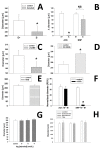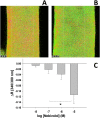The Beta-1-Receptor Blocker Nebivolol Elicits Dilation of Cerebral Arteries by Reducing Smooth Muscle [Ca2+]i
- PMID: 27716772
- PMCID: PMC5055296
- DOI: 10.1371/journal.pone.0164010
The Beta-1-Receptor Blocker Nebivolol Elicits Dilation of Cerebral Arteries by Reducing Smooth Muscle [Ca2+]i
Abstract
Rationale: Nebivolol is known to have beta-1 blocker activity, but it was also suggested that it elicits relaxation of the peripheral arteries in part via release of nitric oxide (NO). However, the effect of nebivolol on the vasomotor tone of cerebral arteries is still unclear.
Objective: To assess the effects of nebivolol on the diameter of isolated rat basilar arteries (BA) in control, in the presence of inhibitors of vasomotor signaling pathways of know action and hemolysed blood.
Methods and results: Vasomotor responses were measured by videomicroscopy and the intracellular Ca2+ by the Fura-2 AM ratiometric method. Under control conditions, nebivolol elicited a substantial dilation of the BA (from 216±22 to 394±20 μm; p<0.05) in a concentration-dependent manner (10-7 to 10-4 M). The dilatation was significantly reduced by endothelium denudation or by L-NAME (inhibitor of NO synthase) or by SQ22536 (adenylyl cyclase blocker). Dilatation of BA was also affected by beta-2 receptor blockade with butoxamine, but not by the guanylate cyclase blocker ODQ. Interestingly, beta-1 blockade by atenolol inhibited nebivolol-induced dilation. Also, the BKCa channel blocker iberiotoxin and KCa channel inhibitor TEA significantly reduced nebivolol-induced dilation. Nebivolol significantly reduced smooth muscle Ca2+ level, which correlated with the increases in diameters and moreover it reversed the hemolysed blood-induced constriction of BA.
Conclusions: Nebivolol seems to have an important dilator effect in cerebral arteries, which is mediated via several vasomotor mechanisms, converging on the reduction of smooth muscle Ca2+ levels. As such, nebivolol may be effective to improve cerebral circulation in various diseased conditions, such as hemorrhage.
Conflict of interest statement
The authors have declared that no competing interests exist.
Figures






References
-
- Faraci FM. Role of nitric oxide in regulation of basilar artery tone in vivo. Am J Physiol. 1990;259(4 Pt 2):H1216–21. . - PubMed
MeSH terms
Substances
LinkOut - more resources
Full Text Sources
Other Literature Sources
Research Materials
Miscellaneous

